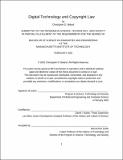Digital technology and copyright law
Author(s)
Beland, Christopher D. (Christopher David), 1978-
DownloadFull printable version (329.3Kb)
Other Contributors
Massachusetts Institute of Technology. Program in Science, Technology and Society.
Advisor
David I. Kaiser.
Terms of use
Metadata
Show full item recordAbstract
Intellectual Property is an ideology of the late Twentieth Century which reserves property-like rights in information, so that creators may extract its economic value. Current American copyright law draws mainly from this concept; it has been constructed through history by negotiation between various established economic interests. Information Freedom is a competing ideology which has been successful in the software community. It emphasizes the dangers of over-propertization and the benefits of freely accessible resources, especially non-depletable information resources. Compromise must be reached in a practical (non-ideological) fashion in order to achieve the social goals of: production of creative content (encouraged by fair but not excessive compensation for creators); promotion of scientific, political, technical, artistic, cultural, and economic progress by removing obstacles to accessing content and taking advantage of innovations which change the status quo; protection of creative freedom; and ensuring quality and diversity in the content which is created. Civil disobedience as a means to achieve these goals may be counterproductive if it results in tighter technological restrictions on content availability or stricter legal mechanisms; legal reforms proposed by Lawrence Lessig and Jessica Litman are unlikely to be enacted. Internet-based technologies have strong potential to increase exposure to diversity, decrease costs, and improve the subjective experience for music consumers. Cheaper film-making equipment may have similar positive effects for motion pictures to a lesser degree. Internet bandwidth and other practical limitations suggest that immediate changes in video distribution and consumption patterns are more likely to be driven by the availability of Digital Video Recorders, or perhaps competing Video On Demand services. Different economic models which fund content creation may be appropriate for different applications, and may in some cases further social goals better than strong propertization. Alternative models include voluntary contributions (either from creators or consumers); indirect benefit by establishing reputation, selling related services, cross-promotion, or selling advertising; and public funding. The history of telecommunication, including the telegraph, radio, television, and the Internet, provides evidence that important uses for new technology may not be initially obvious, that the maturation of digital information technology and related economic models is just beginning.
Description
Thesis (S.B.)--Massachusetts Institute of Technology, Program in Science, Technology, and Society, 2002. Includes bibliographical references (p. 88-108). This electronic version was submitted by the student author. The certified thesis is available in the Institute Archives and Special Collections.
Date issued
2002Department
Massachusetts Institute of Technology. Program in Science, Technology and SocietyPublisher
Massachusetts Institute of Technology
Keywords
Program in Science, Technology and Society.